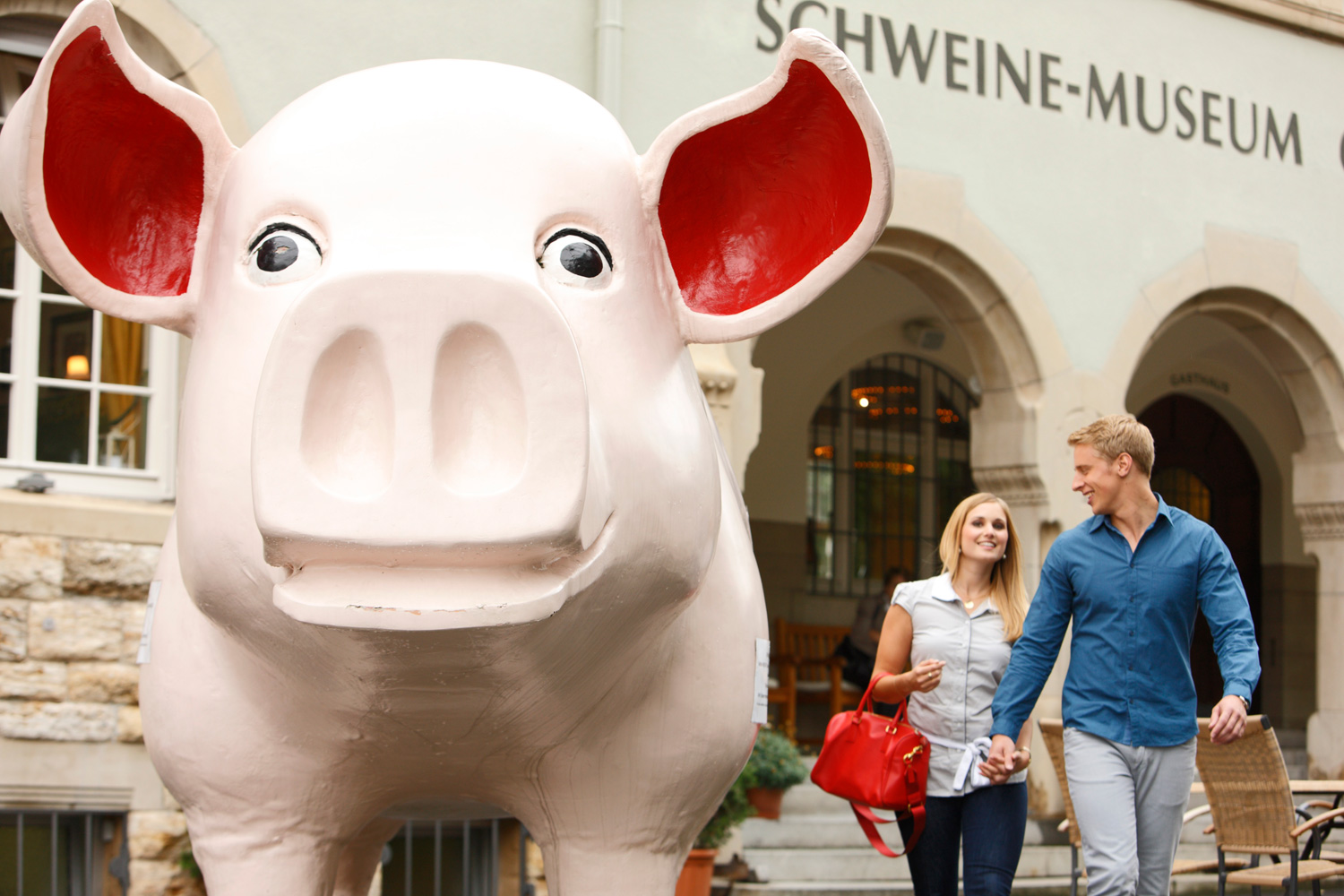From bread and pigs to thimbles and bikinis
SouthWest Germany’s quirky museumsSkurrile Museen in Baden-Württemberg

STUTTGART – SouthWest Germany, the German federal state of Baden-Württemberg, is known for its rich cultural heritage. Alongside grand palaces, mighty castles and industrial monuments are glamourous theatres, opera houses and world-class exhibition halls. But there are also quirky museums that are amusing, intriguing and even bizarre, especially in the towns and villages between the Tauber Valley and Freiburg.
Bad Rappenau’s BikiniARTmuseum: Swimwear through the ages
Do you want to see the world’s most valuable bikini? Or swimsuits worn by Marilyn Monroe, Brigitte Bardot, Esther Williams and Scarlett Johansson? Head for Bad Rappenau, an hour north of Stuttgart. Opened in 2020, the BikiniARTmuseum has a unique collection of swimwear. There are examples from around the world – and they date from the past three centuries. The star attraction has to be the Golden Réard, the only surviving bikini actually designed by its inventor, Frenchman Louis Réard. Famous names range from Triumph, Naturana and Jantzen to couture labels, such as Chanel, Pucci and Dior. Styles include a full-body costume from 1870 and a revealing Brazilian swimsuit, condemned by the Bishop of Rio de Janeiro. In addition, there is modern art featuring swimwear, an exhibit about Woman Power and Body Positivity, as well as the world’s largest collection of bathing caps!
Pforzheim’s DDR Museum: West looks East
Miles from the old border with East Germany, Pforzheim’s DDR Museum is the only museum in the western federal states that examines the history of the DDR in the Communist era. Its aim is to raise awareness of democracy, address human rights and promote discussion about what went on from 1945 to the fall of the wall in 1990. With numerous exhibits from all areas of society, the message is aimed particularly at the younger generation, who only know life after German reunification. Particularly helpful are the “living history books”, the museum guides who lived in the DDR and can describe what life was like under a dictatorship. Pforzheim is an hour northwest of Stuttgart.
Stuttgart’s Pig Museum: The world of pork
Germans love pork, so it should be no surprise to find a museum devoted to the pig. In fact, this is the world’s biggest! Among the 50,000 exhibits gathered from every corner of the globe are lucky pigs, piggy banks and soft, cuddly pigs. Some are made of wood, fabric or cork, while others are ceramic, pottery or cast-iron. There are pig-themed mugs, mailboxes, ties and even a porky tram. In what was once a slaughterhouse in East Stuttgart, the Pig Museum has 27 rooms, covering topics ranging from zoology, culture, mythology and symbolism to how pigs have been represented in art or as curiosities. As for the spacious beer garden and restaurant, it serves – what else but – pork! Grilled suckling pig, crispy pork knuckles and other local Swabian pork dishes.
stuttgart-tourist.de/en/a-pig-museum
Ulm’s Museum for Bread and Art: The staff of life
Paintings featuring loaves of bread and grain harvests; sculptures with bread; special exhibitions about the importance of bread through the ages: all are under one roof at the Museum for Bread and Art. Founded in 1955 in Ulm, 90 minutes southeast of Stuttgart, and set in a 400-year-old house, the world's first bread museum has two themes: art and bread. The art collection ranges from the 15th to the 21st century and features renowned painters, such as Rembrandt, Chagall and Picasso, as well as Pieter Breughel and Salvador Dalí. Then there are monthly events dealing with bread in a cultural or historical context, including baking specially-shaped bread for traditional seasonal treats.
Europa-Park’s Krønasår Museum-Hotel: Night at the Museum
Although this is not a museum in the traditional sense, the Krønasår Museum-Hotel at the Europa-Park theme park has been tastefully designed to look like a natural history museum. Open since 2019, it has glass showcases filled with historical and nautical finds. And, hanging in the lobby to welcome guests is the huge skeleton of Svalgur, the sea snake from Rulantica, the exciting themed waterpark next door. Even the bedrooms are themed with maps and travel memorabilia, so guests feel as if they are walking in the footsteps of famous explorers and adventurers.
europapark.de/en/accommodation
The Kaiserstuhl’s Corkscrew Museum: Popping a cork
With its gloriously sunny climate, SouthWest Germany is famous for its wines. And the sunniest vineyards of all are on the Kaiserstuhl, three hours southwest of Stuttgart. Here, in the charming wine village of Burkheim, an ancient barn is home to the Corkscrew Museum (Korkenzieher Museum). Described by a German newspaper as “perhaps the smallest and most unusual museum in Germany”, it holds the private collection of Bernhard Maurer. What started in 1995 with a purchase in flea market now extends to more than 1,000 examples of gadgets designed to remove corks from bottles. That challenge dates back 350 years, to the time when corks were first used to seal wine in bottles. On a guided tour, Bernhard himself regales visitors with tales about uncorking bottles. And entry to his museum is free.
Downloads
- From pigs to thimbles and bikinis.doc (doc - 704 KB)
- From pigs to thimbles and bikinis.pdf (pdf - 167 KB)
